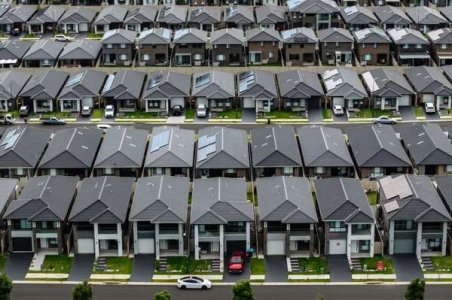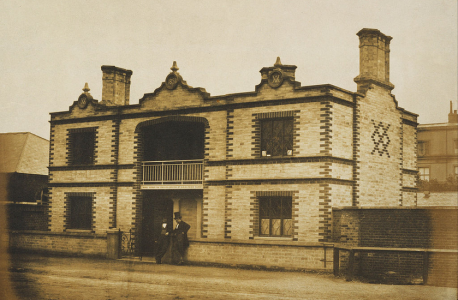This photo of an Aussie suburb sparks discussions about the country's housing crisis
By
Danielle F.
- Replies 39
The Australian dream of owning a spacious home with a sprawling backyard is ingrained in our psyche.
It's a vision that conjures up images of children playing cricket on the lawn, weekend barbecues with family and friends, and a sense of community many of us hold dear.
However, an aerial photograph of a suburb has ignited a fiery debate about the future of housing in Australia and what this means for our way of life.
The Ponds, which was transformed from pastoral farmland into a residential area in 2007, now boasts around 4,500 homes housing an estimated 12,000 residents.
The suburb's rapid development and the resulting high-density living conditions have become a hot topic, with the viral image sparking thousands of comments and concerns.
The photograph posted by a social media user showed rows upon rows of tightly packed houses.
According to commenters, each house has a price tag of at least $1.2 million.
The median house price in The Ponds is even higher, at $1.548 million, per CoreLogic data.
This figure surpasses the greater Sydney median of $1.414 million, requiring a couple to earn a combined income of $238,000 to secure a bank loan for a home in the area.
The debate has extended beyond the financial implications, touching on privacy, safety, and climate issues.
Residents and onlookers alike have criticised the lack of space between homes.
'If you sneeze out a side window, your neighbour will catch your cold,' one comment read. 'This picture makes me feel claustrophobic just looking at it.'
Others have lamented the absence of backyards and trees, describing the area as 'just greyness' and 'depressing'.
Safety concerns have also been raised, particularly regarding the risk of fire spreading rapidly through the connected dwellings.
'One home catches fire, and the entire row burns down. Great design,' another comment read.
The homes' dark roofs and reliance on air conditioning were criticised for contributing to higher temperatures in the summer months—raising questions about the sustainability and livability of high-density housing.
The conversation has also veered into the territory of immigration and government policy, with some attributing the need for high-density housing to Sydney's growing population fueled by immigration.
Critics argue that this has led to unsustainable levels of development driven by greed and a disregard for the quality of life of potential homeowners.
Amidst the sea of modern homes, one defiant family stands out.
The Zammit family has refused to sell their five-acre property, which is now surrounded by new developments.
Despite receiving offers of up to $50 million, the Zammits have held onto their land—a remnant of the area's past, characterised by unique homes and ample space.
See the changes upon The Ponds here:
Source: 7News Australia/YouTube

What do you think of The Ponds's design? How do you maximise a limited home space for your comfort? Share your opinions in the comments below.
It's a vision that conjures up images of children playing cricket on the lawn, weekend barbecues with family and friends, and a sense of community many of us hold dear.
However, an aerial photograph of a suburb has ignited a fiery debate about the future of housing in Australia and what this means for our way of life.
The Ponds, which was transformed from pastoral farmland into a residential area in 2007, now boasts around 4,500 homes housing an estimated 12,000 residents.
The suburb's rapid development and the resulting high-density living conditions have become a hot topic, with the viral image sparking thousands of comments and concerns.
The photograph posted by a social media user showed rows upon rows of tightly packed houses.
According to commenters, each house has a price tag of at least $1.2 million.
The median house price in The Ponds is even higher, at $1.548 million, per CoreLogic data.
This figure surpasses the greater Sydney median of $1.414 million, requiring a couple to earn a combined income of $238,000 to secure a bank loan for a home in the area.
The debate has extended beyond the financial implications, touching on privacy, safety, and climate issues.
Residents and onlookers alike have criticised the lack of space between homes.
'If you sneeze out a side window, your neighbour will catch your cold,' one comment read. 'This picture makes me feel claustrophobic just looking at it.'
Others have lamented the absence of backyards and trees, describing the area as 'just greyness' and 'depressing'.
Safety concerns have also been raised, particularly regarding the risk of fire spreading rapidly through the connected dwellings.
'One home catches fire, and the entire row burns down. Great design,' another comment read.
The homes' dark roofs and reliance on air conditioning were criticised for contributing to higher temperatures in the summer months—raising questions about the sustainability and livability of high-density housing.
The conversation has also veered into the territory of immigration and government policy, with some attributing the need for high-density housing to Sydney's growing population fueled by immigration.
Critics argue that this has led to unsustainable levels of development driven by greed and a disregard for the quality of life of potential homeowners.
Amidst the sea of modern homes, one defiant family stands out.
The Zammit family has refused to sell their five-acre property, which is now surrounded by new developments.
Despite receiving offers of up to $50 million, the Zammits have held onto their land—a remnant of the area's past, characterised by unique homes and ample space.
See the changes upon The Ponds here:
Source: 7News Australia/YouTube
Key Takeaways
- An aerial photo highlighting the dense housing in The Ponds, a suburb of Sydney, has sparked significant debate about the future of Australian housing and the impact of urban development.
- The Ponds, initially farmland, was converted into a residential area with 4,500 homes, leading to concerns about privacy, safety, quality of life, and environmental considerations such as the heat island effect.
- With median house prices at The Ponds exceeding the wider Sydney median, affordability and the impact of high immigration on housing demand are among the critical issues discussed.
- Amidst the area's transformation, the Zammits family resisted selling their five-acre property to developers, highlighting a contrast between past and present living conditions and values in the area.
Last edited:









